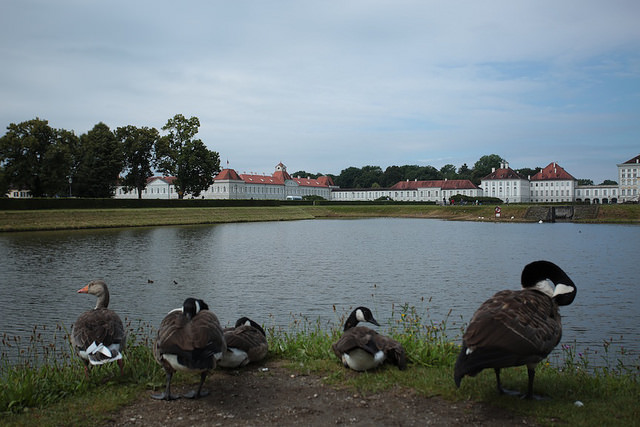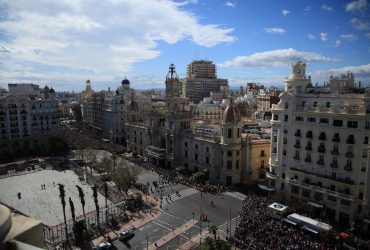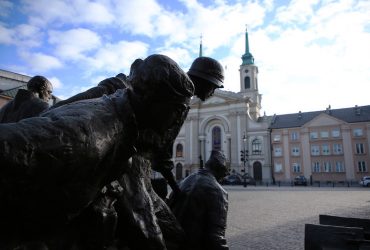One of the places that struck me most during my trip to Munich was the Castle of Nymphenburg, the nymphs castle. The palace, built in Baroque style, is located in the middle of a vast French park and was the summer residence of the kings of Bavaria.
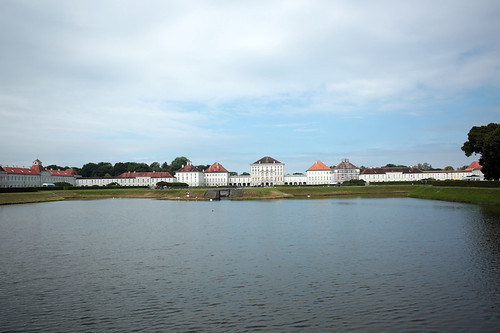 – Entrance ticket:
– Entrance ticket:
1 April – 15 October: 11.50 € (9 € reduced)
October 16th – March 31st: € 8.50 (€ 6.50 reduced).
– Opening hours:
Castle (every day)
From April to October 15th: 9 am-6 pm
From October 16th to March: 10 am-4 pm
Amalienburg, Badenburg, Pagodenburg and Magdalenenklause
From April to 15 October: 9 – 18 (every day); From October 16th to March: closed. For more information (or variations) I refer you, of course, to the official website.
– How to get there: from the Hauptbahnhof station there is the tram 17, which arrives at the castle in about 13 minutes.
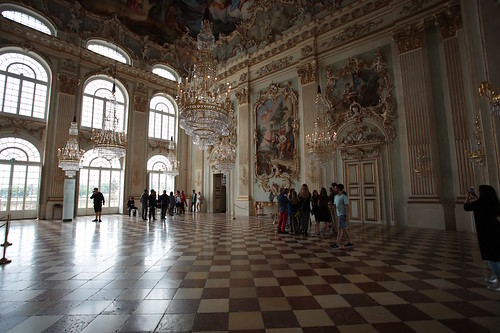 At the cash desk, along with the ticket, we bought two guides on the castle, and we left the backpacks to the wardrobe. My friend and I started the visit from the building: frescoes, paintings and stories to discover are so many that it is a must to visit them with calm and patience. The starting point for the visit is the Sala di Pietra (Hall of Stone): an ancient hall for parties, today it is the hall that unites the wings of the building and the apartments. At the northern end is located the chapel of the palace. The frescoes are, of course, something spectacular and, in my opinion, one of the most beautiful is the one that represents the Goddess Ceres, in the northern drawing room.
At the cash desk, along with the ticket, we bought two guides on the castle, and we left the backpacks to the wardrobe. My friend and I started the visit from the building: frescoes, paintings and stories to discover are so many that it is a must to visit them with calm and patience. The starting point for the visit is the Sala di Pietra (Hall of Stone): an ancient hall for parties, today it is the hall that unites the wings of the building and the apartments. At the northern end is located the chapel of the palace. The frescoes are, of course, something spectacular and, in my opinion, one of the most beautiful is the one that represents the Goddess Ceres, in the northern drawing room.
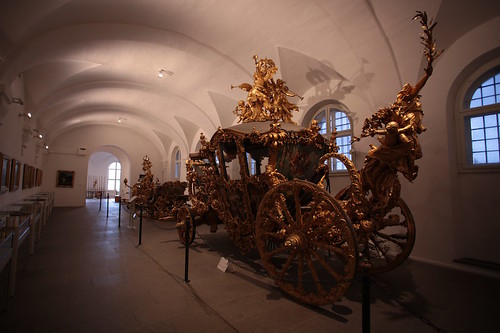 The museum of carriages (Marstallmuseum) is located inside the stables of the court. Do I need to tell you “in words” how beautiful are the carriages on display or just the photo to explain it to you? The entrance is included in the castle ticket, and the access to the museum is not very far from the castle gate that overlooks the garden. I recommend you visit it as soon as you finish the tour of the castle, before going to the discovery of the gardens and all the buildings that are there. The gardens are gigantic (and very fresh even in summer), and the first half of July was a period of litters: along the canals that pass through the park there are many families of ducks (and be careful because the adults are very protective, even towards puppies which aren’t theirs).
The museum of carriages (Marstallmuseum) is located inside the stables of the court. Do I need to tell you “in words” how beautiful are the carriages on display or just the photo to explain it to you? The entrance is included in the castle ticket, and the access to the museum is not very far from the castle gate that overlooks the garden. I recommend you visit it as soon as you finish the tour of the castle, before going to the discovery of the gardens and all the buildings that are there. The gardens are gigantic (and very fresh even in summer), and the first half of July was a period of litters: along the canals that pass through the park there are many families of ducks (and be careful because the adults are very protective, even towards puppies which aren’t theirs).
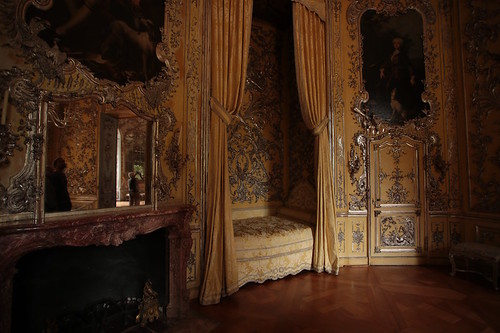 The first stop in the garden is the Amalienburg building: a rococo-style hunting lodge, built by Emperor Charles VII as a gift to his wife Maria Amalia who was, apparently, a great hunting enthusiast (it seems that he loved to stay more with his dogs than with his bridesmaids). The room called “mirrors’ salon” is, of course, a room that leaves you breathless, but the most curious room is certainly the bedroom: in the colours of yellow, this room “hides” a small bed along one of the walls.
The first stop in the garden is the Amalienburg building: a rococo-style hunting lodge, built by Emperor Charles VII as a gift to his wife Maria Amalia who was, apparently, a great hunting enthusiast (it seems that he loved to stay more with his dogs than with his bridesmaids). The room called “mirrors’ salon” is, of course, a room that leaves you breathless, but the most curious room is certainly the bedroom: in the colours of yellow, this room “hides” a small bed along one of the walls.
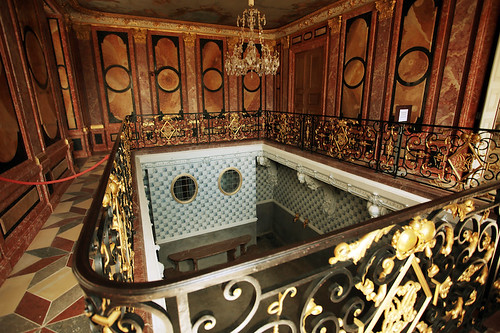 Then, still in the castle large park, there is the Badenburg building, the “baths’ castle“. The Festival Hall is one of the first room we visited: inspired by the luxury of the Turkish baths, It can be described only as sumptuous. In the bathrooms Hall, the walls are covered with painted Dutch tiles and, at the bottom, there is the pool large enough to swim. You can’t get to the pool floor, you can only look at it from the level above, but I suggest you look at it anyway.
Then, still in the castle large park, there is the Badenburg building, the “baths’ castle“. The Festival Hall is one of the first room we visited: inspired by the luxury of the Turkish baths, It can be described only as sumptuous. In the bathrooms Hall, the walls are covered with painted Dutch tiles and, at the bottom, there is the pool large enough to swim. You can’t get to the pool floor, you can only look at it from the level above, but I suggest you look at it anyway.
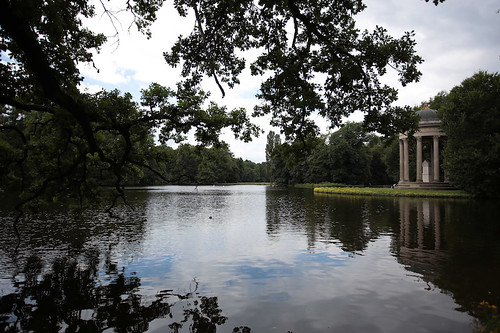 Then my friend and I enjoyed the walk through the park and, overlooking the largest lake in the vast park, the Badenburg lake, we find the Tempietto Monoptero.
Then my friend and I enjoyed the walk through the park and, overlooking the largest lake in the vast park, the Badenburg lake, we find the Tempietto Monoptero.
Visible from every point on the shore, formerly the temple of Apollo was built of wood and was transformed by Ludwig I between 1862 and 1865; on the domed roof, supported by ten columns. there is a representation of Apollo. Inside there is a stele with a dedication by Ludovico I. Obviously it is possible to approach and climb the steps of the temple to enjoy a better view of the lake and the part of the park that overlooks it. We pass through the high waterfall, which is not so large, and we arrive at Pagodenburg.
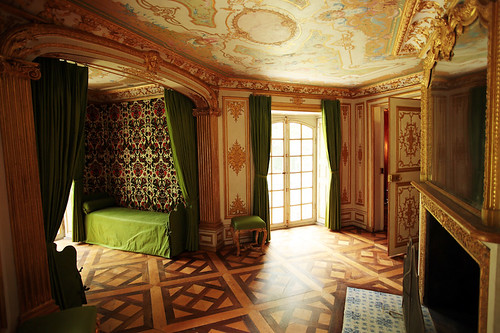 It is located north of the main canal and was built in the days of Max Emanuel, between 1716 and 1718, to be restored in Rococo style about 50 years later. Fascinating are the rooms on the first floor of the building: these room are very tiny rooms, characterised by paintings that give the rooms an “Asian” look. During our tour, my friend and I we stopped to have lunch at the restaurant inside the park and where you can choose between the service restaurant and the self-service (we have opted for the first option, the prices of the dishes were not so higher except for water). The last stage of our visit is the “Maddalena Hermitage“, which amazed me as I expected.
It is located north of the main canal and was built in the days of Max Emanuel, between 1716 and 1718, to be restored in Rococo style about 50 years later. Fascinating are the rooms on the first floor of the building: these room are very tiny rooms, characterised by paintings that give the rooms an “Asian” look. During our tour, my friend and I we stopped to have lunch at the restaurant inside the park and where you can choose between the service restaurant and the self-service (we have opted for the first option, the prices of the dishes were not so higher except for water). The last stage of our visit is the “Maddalena Hermitage“, which amazed me as I expected.
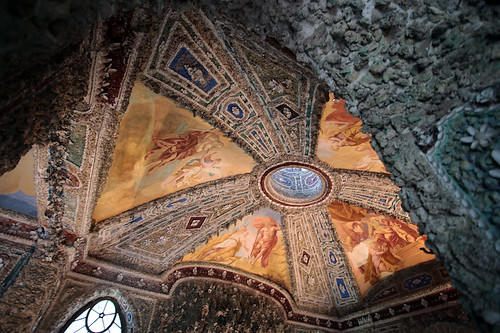 The full name is Hermitage of Santa Maddalena and is hidden in a wooded area behind the Grande Parterre. It is a building built without any embellishment and with coarse bricks. It seems to be in a state of abandonment: this aspect of it was desired because it had to resemble the dwelling of a hermit and symbolise the transience of human life. Its construction was commissioned by Max Emanuel and was begun in 1725. The chapel was designed like a cave, and behind it, there is the apartment of the elector prince. The interior has no embellishment, apart from the two candelabra on either side of the crucifix.
The full name is Hermitage of Santa Maddalena and is hidden in a wooded area behind the Grande Parterre. It is a building built without any embellishment and with coarse bricks. It seems to be in a state of abandonment: this aspect of it was desired because it had to resemble the dwelling of a hermit and symbolise the transience of human life. Its construction was commissioned by Max Emanuel and was begun in 1725. The chapel was designed like a cave, and behind it, there is the apartment of the elector prince. The interior has no embellishment, apart from the two candelabra on either side of the crucifix.
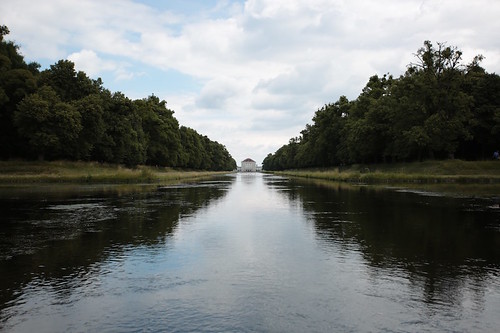 The park is enormous, and the things we have not seen are many, but to do all this around it took us about 4 hours including a stop for lunch. My advice is to walk calmly making a selection of what to see (for example I was very interested in seeing the Hermitage and very little to visit the places we skipped, which were still “secondary” attractions).
The park is enormous, and the things we have not seen are many, but to do all this around it took us about 4 hours including a stop for lunch. My advice is to walk calmly making a selection of what to see (for example I was very interested in seeing the Hermitage and very little to visit the places we skipped, which were still “secondary” attractions).
There are two more things that I wanted to specify to conclude this post:
– The farden hasn’t a entrance fee, as it is a public park (a lot of people come in only for a walk); you do not have to pay the ticket if you do not want to visit the castle;
– The admission ticket allows you to visit all the buildings mentioned in the post;
Nymphenburg Castle – Munich Surroundings
